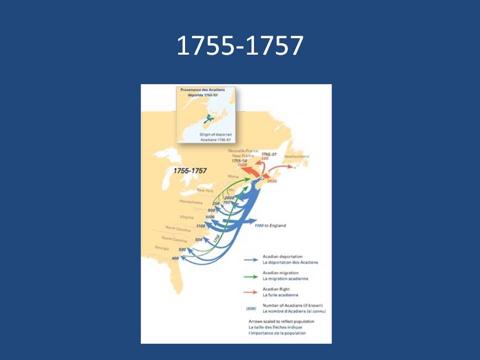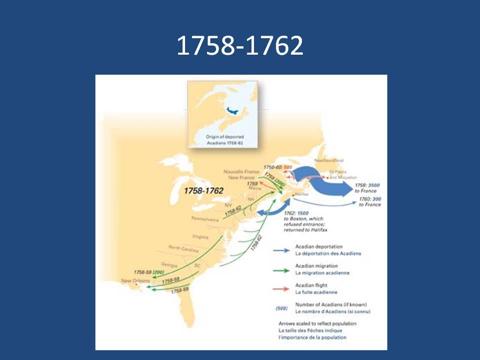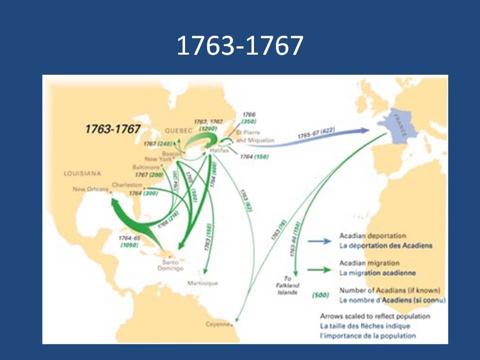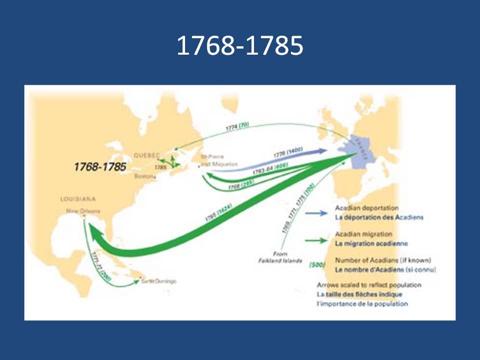Amelia Catherine Butman
WST 301 – Rhea Cote Robbins
Final Paper
12/16/09
Acadians of
the Early Settlements
&
Le Grand Dérangement

Acadians have a historical
background that influences much of the rest of Canada
and the United States. From the early exploration of
the land to the Deportation of 1755 to their
present-day culture, Acadian women have played a
significant role in North America’s history.
European colonists from west-central France first
established the St. Croix Island in 1604, before Jamestown
was established in 1608. However, the settlement was moved
to Port Royal in 1605 due to a harsh winter and several
deaths caused from scurvy.
The
fur trade industry was thriving because of the immense role
women played between the white settlers and the native men.
Native women would marry European settlers to gain
influence and status within their own native societies.
“Because of their sex, Indian women were able to become an
integral part of fur trade society in a sense that Indian
men never could. As country wives of the traders, Indian
women lived substantially different lives when they moved
within the forts. Even within the tribes, women who acted
as allies of the whites can also be observed; certain
circumstances permitted individual women to gain positions
of influence and act as “social brokers” between the two
groups” (Kirk 42). These Acadian women, and Indian women
alike, were seen as “women in between,” the direct
connection to link the newly established New France and
Europe. The outcome of these relationships was so immense
that they could influence either side, the white settlers
or the Indian natives, to create an economy that would
benefit them best. “The Indian woman valued the economic
advantage brought by the traders” so much that they were
able to manipulate the trade system to gain the best
materials and goods their native societies needed (Kirk
42).

The marriage alliances
greatly benefited the Indian tribes both through
social and economic resources. European settlers
seemed to benefit in high regards because of the
domestication of Indian women. “Not only did [European
settlers] fill the sexual void created by the absence
of white women, but they performed such valuable
economic tasks as making moccasins and netting
snowshoes that they became an integral if unofficial
part of the fur trade work force” (Kirk 42). While
this was an excellent point for the settlers, Natives
saw that “the martial alliance created a reciprocal
social bond which served to consolidate his economic
relationship with the trader” (Kirk 42). However,
there are several negative factors the marriage
alliances had on Indian women. Indian women were “more
exposed to diseases, [and] the Indian wives of traders
suffered more in childbirth than they had in the
primitive state” (Kirk 50). Taboos quickly started in
regards to the sexual activity of Indian women, “and
evidence suggests that Indian men regarded their
European counterparts as very licentious” (Kirk 50).

Apart from this thriving
industry, King Henry rescinded the royal fur monopoly
of le Sieur de Monts forcing the last of the Acadians
to leave Port Royal in August of 1607. King Henry’s
excuse for revoking the monopoly was because he
believed “that the income was insufficient to justify
supplying the colony further” (Acadia). King Louis XIV
confiscated the Acadians’ land and all the rights to
it and the minerals found there would belong to
Nicolas Denys, appointed by the King in 1674. The
Dutch West India Company once again sought after
Acadia in 1678 as a paper claim. Luckily, this claim
was never successful. After the British defeated the
French in King William’s War of 1690-1697, the British
returned the land to the French in a peace treaty.
However, the British recaptured it during Queen Anne’s
War of 1702-1713. In 1713, the Acadian residents were
given one year to pledge British allegiance or to
leave the country. The Acadians stood their ground,
though, and were prepared to establish Fortress
Louisbourg on present-day Cape Breton Island. This
caused the British to be weary of the Acadians and
suspect disloyalty among the Natives.

At the onset of the French
and Indian War in 1755, the British attacked Acadian
homes because they saw them as disloyal and for taking
the French side. This led to the Great Deportation.
Acadians who did not take the oath were forced to flee
from Nova Scotia to France or other British American
colonies. However, some maintained their French roots
and escaped to the French-controlled part of Canada or
into the Atlantic Canadian wilderness where they
established French settlements, such as L’Acadie in
Quebec. Some Acadians fled even further to Louisiana
where the name “Acadian” had been progressed into
“Cajun.” Britain did let some Acadians back into Nova
Scotia, but they had to stay in small groups in former
settlements, like Port Royal. Below is the
proclamation given by Charles Lawrence through John
Winslow:
“Gentlemen, - I have received
from his Excellency, Governor Lawrence, the King's
Commission which I have in my hand, and by whose orders you
are conveyed together, to Manifest to you His Majesty's
final resolution to the French inhabitants of this his
Province of Nova Scotia, who for almost half a century have
had more Indulgence Granted them than any of his Subjects
in any part of his Dominions. Whatuse you have made of them
you yourself Best Know. The Part of Duty I am now upon is
what though Necessary is Very Disagreeable to my natural
make and temper, as I Know it Must be Grievous to you who
are of the Same Species. But it is not my business to
annimadvert, but to obey Such orders as I receive, and
therefore without Hesitation Shall Deliver you his
Majesty's orders and Instructions, Vist:-
"That your Land & Tennements, Cattle of all Kinds and
Livestocks of all Sorts are forfeited to the Crown with all
other your effects Savings your money and Household Goods,
and you yourselves to be removed from this Province.”
(LeBlanc)
John
Winslow had promised them his help and guidance in assuring
that their belongings will be safe and secure. He told the
Acadians, “I am Through his Majesty’s Goodness Directed to
allow you Liberty to Carry of your money and Household
Goods as Many as you Can without Discommoding the Vessels
you Go in.” From this section, it seems as though Winslow
wanted to aid the Acadians in any suffrage they might come
upon. He leaves them with this, “[I] hope that in what Ever
part of the world you may Fall you may be Faithful
Subjects, a reasonable & happy people.” (LeBlanc)

Known to the deportees as
Le Grand Dérangement, the Great Deportation forced the
Acadian population out of their rooted homeland to
other British-controlled colonies between 1755 and
1763, such as the thirteen British North American
colonies, France, Louisiana and Britain. Charles
Lawrence the British governor and the Nova Scotia
Council order the upheaval, leading to thousands of
deaths. Both Canada and England had strong
representation and criticism against the movement. Due
to the Treaty of Utrecht on 1713, “tensions between
the French and English that had existed in Acadia
since the territory was ceded to the British” led to
the Acadian removal. The British became weary of the
loyalties the French held for the newly created colony
of Nova Scotia, so they gave the native an ultimatum
of swearing allegiance to Britain or be expelled from
the region. After offering to swear neutrality, the
loyal French population was cast out to succumb to the
opinions and faces of regions that would not accept
them. “Approximately 7,000 Acadians were deported
during 1755” and about 2.700 Acadians died due to the
poor health environment on the prison ships. Another
10,000 suffered severely in the winter of 1755-1756.
According to British records, “There were
approximately 23,000 Acadians before the deportation…,
but only an estimated 10,000 survived.” (Expulsion of
the Acadians)
The
Mi’kmaq tribe in Quebec helped thousands of Acadians
survive. Although they were being hunted, killed, and
scalped by colonial rangers, the Mi’kmaq still helped hide
the Acadians in the countryside to avoid deportation until
everything settled down. The British seized their land and
they were greatly reduced in numbers from the immigration
wave of 1761. “Those Mi’kmaq who managed to elude the
British provided crucial support to many refugee Acadians
who were relatives.” However, the British colonies began
passing laws “forbidding the groups [Acadians and Mi’kmaq]
to speak or intermarry, but they were not successful in
keeping the populations separated.” The Mi’kmaq aided the
deportees in settling in New France colonies of Quebec and
New Brunswick and others went back to Nova Scotia. During
the American Revolution, however, the settlers would soon
be relocated because of the Loyalist appearance. (Expulsion
of the Acadians)

New England, the
Carolinas, Louisiana and several other ports soon
filled with Acadian deportees. Louisiana at that time
was controlled by Spain, who instantly greeted the
Catholic Acadians. They settled around the Mississippi
River and the prairies to the west, later renamed
Acadiana. “During the 19th century, as Acadians
reestablished their culture, ‘Acadian’ was elided
locally into ‘Cajun’ ” (Expulsion of the Acadians).
First arriving to the area, the Acadians wanted to
develop a “New Acadia.” They asked Ulloa the Spanish
governor for his support, but he urged them to wait.
However, the Acadians, distraught and weak from
disease and emotional distress, they went ahead and
developed themselves further. Letters were sent to
Acadians around the nation urging them to travel to
Louisiana and settle there. “They were welcomed by
authorities and offered land and assistance.” They
region was filling up quickly, so Acadians that wanted
to settle later were dispersed to areas around the
Mississippi River “at key border points of the
English/Spanish border. After all, the Spanish
thought, there was no love lost between the Acadians
and the English. They would make a good ‘buffer’.”
(Herbert)
Soon a rebellion occurred in 1768 to remove Ulloa as the
Spanish governor. In February of that year, families sent
to San Luis de Natchez, which upset Ulloa. “The new
governor, O’Reilly, allowed the San Luis de Natchez
Acadians to travel to the Acadian Coast in December of
1769.” Because of tension created by the Spanish-Acadian
conflicts over settled areas and the instability after the
1768 rebellion, no new families came to New Acadia from
1768 to 1785. At the onset of the Acadian arrival, the
letters sent around the nation finally made their way to
Acadian families in France. Henri Peyroux, traveler from
Louisiana to France, received the help from Acadian Olivier
Theriot to persuade to travel to New Acadia. Because of
their immense about of dedication to the thriving
settlement, “about 1600 Acadians travelled to Louisiana on
seven ships, courtesy of the Spanish government.” Once this
new wave of immigrants arrived in New Orleans, settlement
sites were inspected to see if they were suitable for
housing. About 84% of the new families lived in the homes
picked out for them. The others settled elsewhere.
“Four
of the seven groups primarily settled in the Bayou
Lafourche area. Two of the seven groups primarily settled
along the Mississippi River south of Baton Rouge. The
seventh group primarily settled along lower Bayou des
Ecores.” (Herbert)
However, due to a hurricane in
1794, the Bayou des Ecores settlement merged with the Bayou
Lafourche region. Any Acadians that came after this final
great wave settled into the Acadian melting pot of New
Orleans. All kinds of Acadian culture blossomed in
Louisiana during this time. Some of the old rituals and
celebrations altered over time and deportation. Religion,
however, was a strong hold all Acadians could connect to
with one another to keep their culture thriving. (Herbert)
Religion had a large influence on the newly established
Acadian settlements. “While Acadia was under French rule,
all settlers were required to be baptized in the Roman
Catholic faith” (Acadia). Men from France were recruited to
work in fishing trading companies in Acadian commercial
posts before 1654. Gradually, the settlements grew with
fishermen to add to the small population of Acadians. “The
original settlers were indentured servants and soldiers
brought by the fur-trading companies” (Acadia). Only about
100 surnames existed within the original immigrants,
however. Early settlers married Mi’kmaq women, who were
converted to Roman Catholicism. Peasants from Europe
migrated to Acadia where they were not seen as inferior,
but as equals because they did not have the same goods as
the wealthy people of Europe. Extended families played
large roles in the new settlements. They built homes and
barns, and cultivated and harvested crops. The settlers
even went as far as to build dikes to support the economic
stability. Economic and social advantages were directly
related to relationships. Marriages were arranged to
promote the society’s morale and trade status. Mothers and
father had to agree to the marriage and have it recorded in
the marriage deed. To continue to promote good welfare,
divorce was prohibited in New France, but legal separation
was offered, however rarely used.
As you can see, it was very difficult to find any useful
information about Acadian women in the early establishments
of Canada. When “Acadian women Canada” is typed into
Google, a large majority of the links is about today’s
Acadian families who have set up their own websites to
provide information about their own families’ heritage. The
cite I have provided about the women’s role in the fur
trade business was a reading assignment in my Introduction
to Canadian Studies class this semester. I have found that
the most interesting and intriguing aspect of studying
Acadian women was learning about how Native women used the
fur trade business to gain social status within their own
societies. It seems that these early feminists took
advantage of the weak situation and molded it into
something they could easily control and benefit from. I
would like to research more on how these women took
advantage of the trading industry after they were forced to
flee from Nova Scotia. I would like to even more
importantly learn more about how these women were treated
in these marriages and what negative aspects they had to
encounter to strive, thrive, and survive in such
complicated arrangements.
Bibliography:
"Acadia." Wikipedia, The Free
Encyclopedia. 19 Oct 2009, 20:15 UTC. 21
Oct 2009
<</span>http://en.wikipedia.org/w/index.php?title=Acadia&oldid=320862441>.
“Expulsion of the
Acadians.” Wikipedia, The Free
Encyclopedia. 30 Nov 2009, 20:14
UTC.
13 Dec 2009. < http://en.wikipedia.org/wiki/Expulsion_of_the_Acadians>
Herbert, Tim. “Exile Destination: Louisiana.”
Acadian-Cajun
Genealogy & History. 13
December 2009. <
http://www.acadian-cajun.com/exla.htm>
LeBlanc, Lucie. “The Great Diaspora of 1755.”
Acadian &
French Canadian Ancestral
Home.
13 December 2009. <
http://www.acadian-home.org/deportation.html>
Van Kirk, Sylvia. “Women in Between: Indian Women in Fur
trade Society in Western
Canada.”
http://docutek.ursus.maine.edu/eres/coursepage.aspx?cid=1341&page=docs#